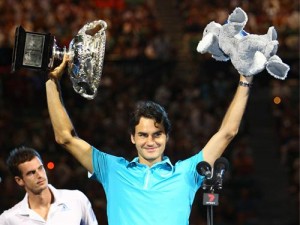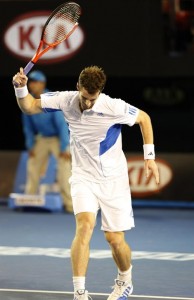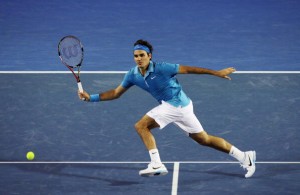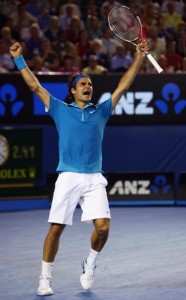Roger Federer, the Smiling Assassin, Puts Andy Murray To the Sword Again

Andy Murray could do little but watch as Roger Federer claimed his 16th Grand Slam title.
Early Sunday morning, and the Great British public has risen early, as one, in the expectation of witnessing something special. It is the growing burden that Andy Murray has borne since he strode into battle in the Australian Open two weeks ago.
With every passing round, with each bigger foe put to the sword, the battle cries have grown.
Now, finally, the lights blaze over the perfect sweep of the Rod Laver arena and the crimson daylight subsides over the Melbourne skyline for the last time.
After two weeks of intense competition, it all comes down to this: Just two men standing.
They are the best that tennis has to offer on this last day of January. The three-time Australian champion, Roger
Federer, is attempting to hold off the aspiring first-time champion, Murray.
Federer has done it before, in the U.S. Open, but 18 months, many matches, sharper skills, and increased maturity have swelled the stature of the young Scot’s shoulders.
And there is something more. In the night sky beyond those spotlights, the stars seem to have shifted into alignment. This is Murray’s 17th Grand Slam in his 22nd year, the very number of Slams and years it took Federer to win his first title.
It is also precisely 50 years since Rod Laver won his first Slam, also in his 22nd year, in this very tournament.

Murray's frustration grew as he had no answers for Federer.
To add a little more bloodlust to the Murray game, it was in this very city, almost 15 years ago to the day, that Fred Perry, the last British man to win a Grand Slam 74 years ago, died.
Perhaps that was the final pinch of salt rubbed into the wounds inflicted on Murray by Federer in this final showdown. For it proved to be nothing less than death by a thousand cuts. Meticulous planning, exquisite execution, straight sets.
The smiling assassin
The signs were there for all to see during the whole tournament. Federer was relaxed, confident, and exuded bonhomie. Jokes and banter came thick and fast, particularly at the hands of Jim Courier. That same confidence translated to Federer’s tennis, even when he lost a set—which he did only twice.
With such relaxation came patience, and that was Federer’s extra, unexpected ingredient from the start of the match.
Both players leave fans and critics bereft of adjectives to describe their panoply of shot-making, touch, speed, and intelligence, but Murray and Federer deploy their talents from different standpoints.
Murray is the counter-puncher who can stand his ground with deep or angled ground strokes, varied spin, and dramatic changes of pace. He bides his time, forcing the error from his opponent or making the killer approach or passing shot.
He has the body strength and deftness of hand to create such winners in the blink of an eye.
Federer plays the offensive game, going for winners within two or three shots of a rally. He can defend, but still looks for an opening to attack the net or drive a zipping forehand.
It was this archetypal Federer who won a break of serve in Murray’s first service game. But what immediately became clear was that Federer was also willing and able to play the waiting game: a less archetypal Federer.

Federer was in control throughout the three-set match.
Rallies unfolded like chess matches, with both players probing all parts of the court, waiting for an opening. It was enthralling tennis, but a patient Federer who is hitting his wide repertoire of shots with conviction and accuracy, is a deadly combination.
Murray had new balls to serve at 3-4 down, but Federer, already into a fresh shirt on this humid Melbourne night, calmly fired off a stunning backhand winner followed by a forehand winner to break.
It was first blood and first set, 6-3, to Federer: dynamic in shot making, penetrating in tactics, but also patient in point building.
Glint of steel and flash of blade
The second set unfolded in similar fashion. Federer continued to engage with Murray in complex rallies, and continued to defend with patience. Murray forced him to defend the backhand wing with a constant barrage from his own sliced backhand but failed to break it down.
Time and again, the Federer backhand parried with Murray’s, until it pierced the defence like the thrust of a foil. With a weakness exposed, Federer found the time and space for a whipped sweep down the line or a dance around the ball for his signature off-forehand winner.
In the blink of an eye, he broke to go 2-1 up and held for a 3-1 advantage.
Federer almost repeated the sword-thrust with a second break, but Murray put up a spirited fight to pull back break points and hold. It was the same flashing blades in the eighth game, and once more Murray fended off the attack.
A familiar steel entered Federer’s eyes as well as his game as he served out a love game to reach 5-3. His next service game was just as incisive, finished off with a searing net attack and winning volley: 6-4.
Silent, serene slayer
Still Federer remained calm, relaxed, focused. Murray seemed to be using a sword of base metal against a weapon of finely-sharpened steel, but his heart and legs continued to wield it with energy and belief.

Even as he continues to increase his record number of grand slam singles titles, Federer, continues to play with passion and determination.
After an easy service game, he gained his first break point chance since the first set, but overplayed a backhand.
Federer held, but in the sixth game, Murray gained three more break points and, with some stunning swordplay at the net, took one of them with a deft passing shot.
The blood rose in Murray’s veins and he continued to attack with gusto to hold his serve easily. He was 5-2 up, and his first serve was beginning to hit the mark.
The crowd roared him on, his box roared him on, and he roared himself on.
The quietest man in the arena was Federer, and despite a few errors from his racket, he radiated calm. Murray attacked him across the full width of the baseline, but Federer defended confidently, and then silently stepped in to attack the Murray second serve at 30-30. It was a last-ditch attempt to retrieve the third set, yet it looked like a stroll in the park.
Federer drew one break point, and was aced. He then produced a deceptive backhand slice that dipped so low across the net that it drew a Murray error. Federer had the break back.
The killer blow
With the set now even at 5-5, Murray was taken to deuce on his serve, but won the game with an ace. Federer applied a stiletto to the heart with a love service game and Murray, with his 5-2 lead whittled away, now opened the tie-break.
He took the early advantage and a 3-1 lead. He forced the play still further with some outstanding crosscourt winners, and appeared in control as he advanced to 6-4. Even then, Federer’s concentration stayed firm. He won back one break point, and was gifted the second by a tense Murray.
At 8-9 Federer again served to save the set, and the patience told once more as a 23-stroke rally eventually drew an error from Murray. The balance switched from set point to championship point three times, until the silent assassin finally outgunned Murray, 13-11. It was a straight sets victory, a fourth Australian title, and a 16th Grand Slam.
Federer finished as he began. Without fireworks, without roars, without tears, but with a relaxed beam that announced, simply, that he is the best.
And questions now have to be asked. When did Federer ever look more at ease? When did he last play more confidently? When has that backhand ever looked stronger, or those feet more nimble? Murray, and many who watched this match, will be scratching their heads to find the answers.
But will Federer still be questioned about his motivation, or whether he has the game to withstand the new generation of players who come out with all guns blazing?
Probably.
However, this was a Grand Slam with all the top players present and correct. Leading the charge was Murray, who hadn’t dropped a set to anyone, was fresh, confident and fitter than he’s ever been. The problem for Murray and the rest is that Federer came to the battle with an expanded battery of ammunition—an improving net game and a flowering backhand in particular.
Add in the maturity of a man in peak fitness and brimming with confidence, and it looks like Federer has thrown down the gauntlet once more.
Cometh the hour, this man will step up.
Very interesting analysis of this match! I saw it quite a bit differently, not having as much as appreciation for Federer's game as frustration for Murray not seeming to be able to put it together. But you're right, one reason Murray couldn't come out firing was that Federer employed his considerable skills to nullifying what Andy could do.
I think a couple of things were at work – one was Andy Murray having a match in which he didn't bring out his attack style soon enough. Andy was complacent (cocky??). Andy CAN really come out swinging, examples include the second set against Cilic, and of course, the first and second sets against Rafa. If he thought he as going to out-tactic Federer, it did not work, and he should have been prepared for that. Andy was not even making his shots. He was making the circus shots against Isner, Nadal, and Cilic. But when it came to Roger, he started missing. Nerves? I'm not seeing it as so much due to Roger's play, but due to Andy's focus in the early stages of the match.
I didn't think Andy would get nervous – he seemed stoic and ready prior to this final, the neophyte nerves having been worked at the USO in 2008. But I think in the post-match demeanor and his remarks at the ceremony, Andy showed us that he was feeling the pressure.
The third set was where the real contest began, to me. Andy got it together. And then we saw Roger's brilliance at work. The level of play went up for both players. And I suppose we can lodge one more in the column for the wonderous era of Roger.
Hi Claudia, thanks for the long response.
How interesting that you see it that differently.
I really didn't think Andy played that badly, simply that Roger kept him so pinned down, and then came up with his best killer shots at the right moment. And didn't let up, except very briefly in the third set when Andy had a few chances he missed. Those were, I think, caused by nerves.
It's a long time since I saw Roger play quite so consistently and calmly. I suppose that's what I was getting at.
My heart went out to Andy in the presentation ceremony – very tough for him, but very gracious.
Ah, now the first comment has appeared again! Apologies for repeating myself!
Hi Claudia, thanks for the long response.
(By the way, this is strange – I thought I'd posted a long response last night and it seems to have disappeared.)
You're right that Andy came out with a game plan that simply wasn't working – Roger's plan was both better and also backed up by remarkable accurate and powerful shotmaking. Of course, we've seen some matches of late from Federer where he has dipped in concentration. But all the signs in Melbourne were of a a supremely confident and relaxed Federer, and what's more, he seems more fit and injury free than in a long time. A perfect specimen, right now, with mind and body in peak condition.
I don't think Murray was complacent or cocky, though I suspect his demeanour suggests he is, and that is part of the image problem he has, especially in the UK. Dour, yes, but he will have shown many people his true colours in the presentation ceremony. Very gracious and very touching.
Great write up of a great man whose strategy paid off big time. I was concerned for a while that Murray might capture the 3d set and find renewed hope – but Federer did not allow the Scot back in the match!! One major down and 3 more to go – who knows what the future will bring! Should be an exciting year~~
Well in truth, Andy *should* have won that third set – it was a howler he played into the net on set point. But then Federer missed a couple of sitters too. A nervy tie-breaker all round. The poor old BBC commentary team were barely able to speak. In fact, John Lloyd admitted it was almost unbearable. But the good thing about the Beeb is that you get some silences during play where they don't feel the need to fill every second with platitudes, or idiotic comments. Trouble is, they only cover Wimbledon and when Andy's playing!